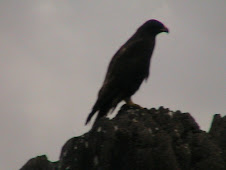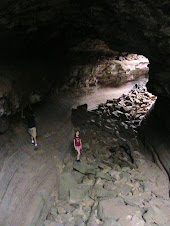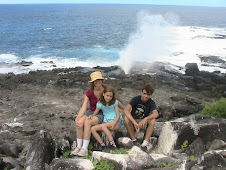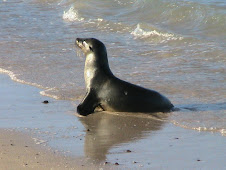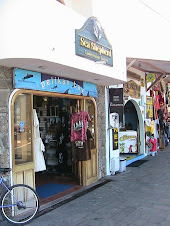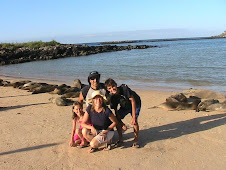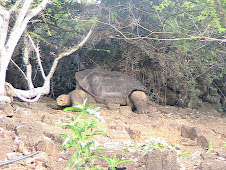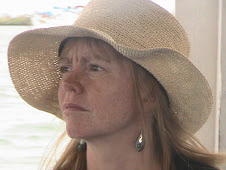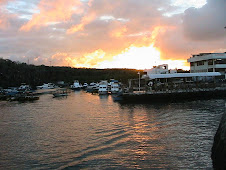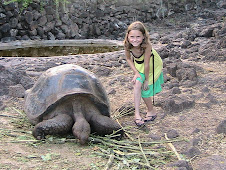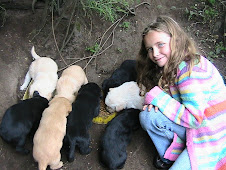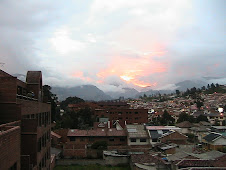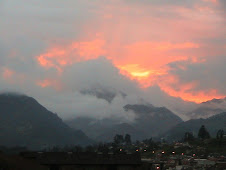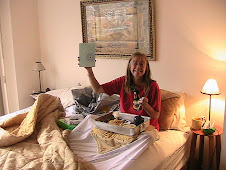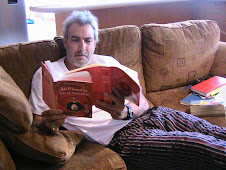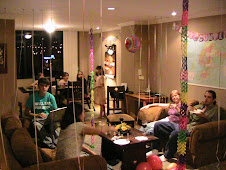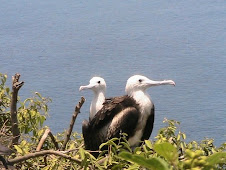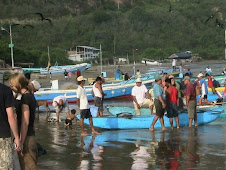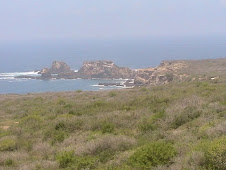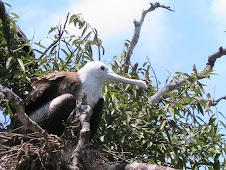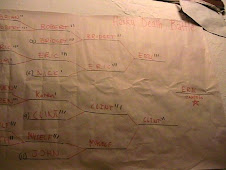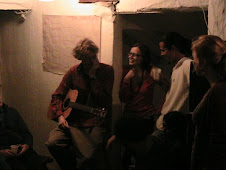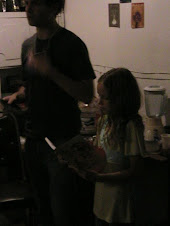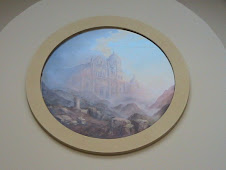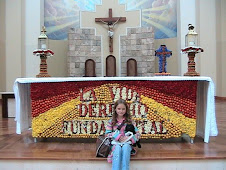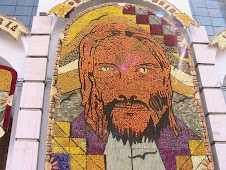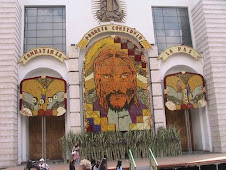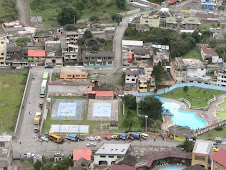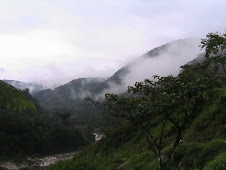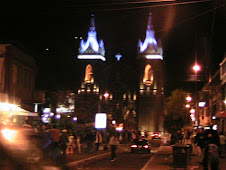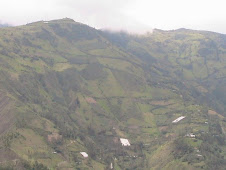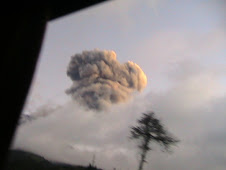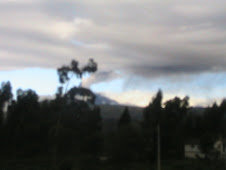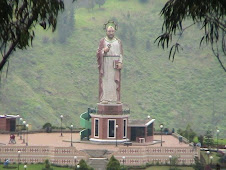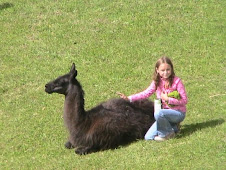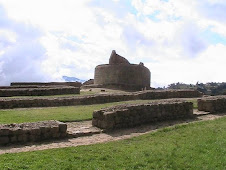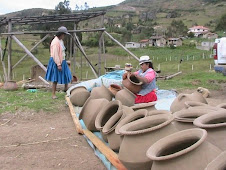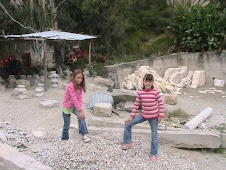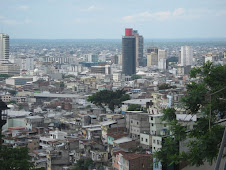
It may be said that natural selection is daily and hourly scrutinising, throughout the world, every variation, even the slightest; rejecting that which is bad, preserving and adding up all that is good; silently and insensibly working, whenever and wherever opportunity offers, at the improvement of each organic being in relation to its organic and inorganic conditions of life. We see nothing of these slow changes in progress, until the hand of time has marked the long lapse of ages, and then so imperfect is our view into long past geological ages, that we only see that the forms of life are now different from what they formerly were.


The climax of our Ecuadorian adventure took us to that place where the Mystery of Mysteries might be viewed – The Galápagos Islands. Located some 600 miles off the coast of Ecuador, it requires a plane trip from Guayaquil and then a combination of ferry and bus to get to the Puerto Ayura in Santa Cruz, the launching point for trekking the islands.
As is always the case in Ecuador transportation adventures precede most travel adventures and this trip proved no different. Our flight from Cuenca to Guayaquil on Sunday night was canceled at the last minute. So we were forced to take a bus ride from Cuenca to Guayaquil. The ride itself, which is usually treacherous as one has to pass over the Caja mountains, was not bad. We were treated to a gaggle of garrulous Uruguayans on tour in Cuenca (lots of “juhz”) with the only difficulty being whether Norm should mix his travel medicines (Tylenol Sinus for airflight with Dramamine for bus travel). He ended up bucking both the pharmaceutical gods and their commandments (Thou shalt take medicine everyday) and went Cold Turkey for the trip. Arriving in Guayaquil ca, 1 AM we managed to get a decent hotel downtown for the night. After a few hours of sleep we found ourselves on the plane to the Galápagos.
The islands are found at the coordinates 1°40'N-1°36'S, 89°16'-92°01'W. Straddling the equator, islands in the chain are located in both the northern and southern hemisphere with Volcan Wolf and Volcano Ecuador on Isla Isabela being directly on the equator line. Española the southernmost island and Darwin the northernmost island are spread out over a distance of 220 km (137 miles).
The Galapagos Archipelago consists of 7,880 square km (3,042 sq. miles) of land spread over 45,000 square km (28,000 miles) of ocean. The largest of the islands, Isabela, measures 4,640 square km and making up half of the total land area of the Galapagos. Volcan Wolf, on Isabela is the highest point with an elevation of 1,707 m (5,600 ft.) above sea level.
DAY 1: MONDAY, MAY 18, 2009 (BALTRA, SANTA CRUZ)
SEPTEMBER 15, 1835 -- This archipelago consists of ten principal islands, of which five exceed the others in size. They are situated under the Equator, and between five and six hundred miles westward of the coast of America. They are all formed of volcanic rocks; a few fragments of granite curiously glazed and altered by the heat, can hardly be considered as an exception. Some of the craters, surmounting the larger islands, are of immense size, and they rise to a height of between three and four thousand feet. Their flanks are studded by innumerable smaller orifices. I scarcely hesitate to affirm, that there must be in the whole archipelago at least two thousand craters.
We landed at the airport on the island of Baltra. The airstrip was originally constructed by the U.S. army to protect the Panama Canal during WWII but was eventually ceded back to the Ecuadorians. This tidbit of information provided us our first experience with the fragility of the islands and the unavoidable theses of Struggle for Existence / Natural Selection. Introduction of foreign species by the U.S. soldiers as well as noise pollution from the planes had effectively eliminated certain populations of species from the island.
During the 1940s scientists decided to move 70 of Baltra's Land Iguanas to the neighboring North Seymour Island as part of an experiment. This move had unexpected results for during the military occupation of Baltra in World War II, the native iguanas became extinct on the island. During the 1980s iguanas from North Seymour were brought to the Charles Darwin Research Station as part of a breeding and repopulation project and in the 1990s land iguanas were reintroduced to Baltra. As of 1997 scientists counted 97 iguanas living on Baltra; 13 of which were born on the islands.
We took the bus-ferry-bus to Puerto Ayora on the island of Santa Cruz. There we loaded up on our boat and then went back to the island to Check out the Charles Darwin Research Center. On the way to the Research Center we passed through the town and took in the local sights. We noted the local Sea Shepherd organization and thought about signing Steve McFadden up but decided to wait on that one. Along with all the ecological trinkets being sold in the local shops, one finds old Darwin being sold as a commodity. And literally, it is the old Darwin (bald and long, gray beard) who is for sale and not the 26-year old Darwin who actually tread upon the islands in 1835. Why sell the old man as the icon? Closer looking to an Old Testament God or Santa Claus? Perhaps the most fascinating commodification was the T-shirt merging old man Darwin with heroic Che Guevara. The brilliance of capitalism or a testament to the syncretic mind of the human beast? How many possible stories can we load into one character?
The natural history of these islands is eminently curious, and well deserves attention. Most of the organic productions are aboriginal creations, found nowhere else; there is even a difference between the inhabitants of the different islands; yet all show a marked relationship with those of America, though separated from that continent by an open space of ocean, between 500 and 600 miles in width. The archipelago is a little world within itself, or rather a satellite attached to America, whence it has derived a few stray colonists, and has received the general character of its indigenous productions. Considering the small size of the islands, we feel the more astonished at the number of their aboriginal beings, and at their confined range. Seeing every height crowned with its crater, and the boundaries of most of the lava- streams still distinct, we are led to believe that within a period geologically recent the unbroken ocean was here spread out. Hence, both in space and time, we seem to be brought somewhat near to that great fact -- that mystery of mysteries -- the first appearance of new beings on this earth.
Anyway, after the business of Darwin we entered the science of Darwin at the Research Center. There we saw a great deal of tortoises from the several islands. Although they provide the islands with both name (“Galápago" is an old Spanish word, meaning saddle) and icon (next to Darwin) they are not a common site in the islands – there are less than 200 in the 13 main islands. They have been slaughtered over the years by various travelers for their meat. Since the tortoises can live for long periods of time with little or no water, and carry upwards to 200 lbs. of meat on their frame, they were ideal for long sea journeys. Introduced species have also destroyed habitat and created competition for resources. So, the Research Center offered probably the best view of these creatures. We stopped by nurseries and visited Lonesome George, who is the last surviving tortoise from one of the islands. He is about 80 yrs. old now so has another 70 years to go to produce some offspring. They’ve been trying to hook him up with related species, but so far no luck.

I have not as yet noticed by far the most remarkable feature in the natural history of this archipelago; it is, that the different islands to a considerable extent are inhabited by a different set of beings. My attention was first called to this fact by the Vice-Governor, Mr. Lawson, declaring that the tortoises differed from the different islands, and that he could with certainty tell from which island any one was brought. I did not for some time pay sufficient attention to this statement, and I had already partially mingled together the collections from two of the islands. I never dreamed that islands, about 50 or 60 miles apart, and most of them in sight of each other, formed of precisely the same rocks, placed under a quite similar climate, rising to a nearly equal height, would have been differently tenanted; but we shall soon see that this is the case. It is the fate of most voyagers, no sooner to discover what is most interesting in any locality, than they are hurried from it; but I ought, perhaps, to be thankful that I obtained sufficient materials to establish this most remarkable fact in the distribution of organic beings.
We returned back to the boat and settled into our routine of boat travel with our group. Our itinerary was to travel by night to different islands, wake up anchored outside a new island, have some breakfast, go for a hike on the island, snorkel around the island, and then return to the boat for lunch, dinner, and relaxation. Tough stuff, I know. Our group consisted of a Norwegians, Danes, Swiss Germans, and Austrians. As usual a very international group who we got along well with.
DAY 2: TUESDAY, MAY 19, 2009 (SANTA CRUZ, SANTA FE)
We started the day with a hike around the twin craters of Santa Cruz. They are not volcanic craters but more like sink holes. We followed this up by getting back on the boat and taking a short journey to the island of Santa Fe. There we had a chance to snorkel for the first time. The highlight of the snorkeling was getting up close to the seals and getting some good above water and underwater shots. After lunch we landed on the island and took a short hike around the beach area. Too many seals to count! They were either frolicking in the surf or lounging on the beach. You could get pretty close to them, even lie down next to them if they were asleep, but too close and you gut some guttural barks and coughs.
WHEN on board H.M.S. 'Beagle,' as naturalist, I was much struck with certain facts in the distribution of the inhabitants of South America, and in the geological relations of the present to the past inhabitants of that continent. These facts seemed to me to throw some light on the origin of species—that mystery of mysteries, as it has been called by one of our greatest philosophers. On my return home, it occurred to me, in 1837, that something might perhaps be made out on this question by patiently accumulating and reflecting on all sorts of facts which could possibly have any bearing on it. After five years' work I allowed myself to speculate on the subject, and drew up some short notes; these I enlarged in 1844 into a sketch of the conclusions, which then seemed to me probable: from that period to the present day I have steadily pursued the same object. I hope that I may be excused for entering on these personal details, as I give them to show that I have not been hasty in coming to a decision.
In considering the Origin of Species, it is quite conceivable that a naturalist, reflecting on the mutual affinities of organic beings, on their embryological relations, their geographical distribution, geological succession, and other such facts, might come to the conclusion that each species had not been independently created, but had descended, like varieties, from other species. Nevertheless, such a conclusion, even if well founded, would be unsatisfactory, until it could be shown how the innumerable species inhabiting this world have been modified, so as to acquire that perfection of structure and coadaptation which most justly excites our admiration.
DAY 3: WEDNESDAY, MAY 20, 2009 (ESPAÑOLA)
We traveled by night to the next island – Española and so woke up with a new island staring us in the face. We continued with our routine of snorkeling and hiking and it was here that we really started to see the diversity of bird and reptile species. Hiking we saw tons of iguanas around the rocks, the ubiquitous seals, blue-footed boobies, and frigate birds; snorkeling, we saw turtles, sharks, and various fish.
Yet unless it be thoroughly engrained in the mind, I am convinced that the whole economy of nature, with every fact on distribution, rarity, abundance, extinction, and variation, will be dimly seen or quite misunderstood. We behold the face of nature bright with gladness, we often see superabundance of food; we do not see, or we forget, that the birds which are idly singing round us mostly live on insects or seeds, and are thus constantly destroying life; or we forget how largely these songsters, or their eggs, or their nestlings, are destroyed by birds and beasts of prey; we do not always bear in mind, that though food may be now superabundant, it is not so at all seasons of each recurring year.
I should premise that I use the term Struggle for Existence in a large and metaphorical sense, including dependence of one being on another, and including (which is more important) not only the life of the individual, but success in leaving progeny. Two canine animals in a time of dearth, may be truly said to struggle with each other which shall get food and live. But a plant on the edge of a desert is said to struggle for life against the drought, though more properly it should be said to be dependent on the moisture. A plant which annually produces a thousand seeds, of which on an average only one comes to maturity, may be more truly said to struggle with the plants of the same and other kinds which already clothe the ground. The missletoe is dependent on the apple and a few other trees, but can only in a far-fetched sense be said to struggle with these trees, for if too many of these parasites grow on the same tree, it will languish and die. But several seedling missletoes, growing close together on the same branch, may more truly be said to struggle with each other. As the missletoe is disseminated by birds, its existence depends on birds; and it may metaphorically be said to struggle with other fruit-bearing plants, in order to tempt birds to devour and thus disseminate its seeds rather than those of other plants. In these several senses, which pass into each other, I use for convenience sake the general term of struggle for existence.
DAY 4: THURSDAY, MAY 21, 2009 (FLOREANA)
Floreana was probably most noteworthy for the great amount of albatross that live on the island. Huge birds who have to take off from the high cliffs in order to get airborne.
Seeing this gradation and diversity of structure in one small, intimately related group of birds, one might really fancy that from an original paucity of birds in this archipelago, one species had been taken and modified for different ends.
DAY 5: FRIDAY, MAY 22, 2009 (NORTH SEYMOUR, BALTRA)
No one ought to feel surprise at much remaining as yet unexplained in regard to the origin of species and varieties, if he makes due allowance for our profound ignorance in regard to the mutual relations of all the beings which live around us. Who can explain why one species ranges widely and is very numerous, and why another allied species has a narrow range and is rare? Yet these relations are of the highest importance, for they determine the present welfare, and, as I believe, the future success and modification of every inhabitant of this world. Still less do we know of the mutual relations of the innumerable inhabitants of the world during the many past geological epochs in its history. Although much remains obscure, and will long remain obscure, I can entertain no doubt, after the most deliberate study and dispassionate judgment of which I am capable, that the view which most naturalists entertain, and which I formerly entertained—namely, that each species has been independently created—is erroneous. I am fully convinced that species are not immutable; but that those belonging to what are called the same genera are lineal descendants of some other and generally extinct species, in the same manner as the acknowledged varieties of any one species are the descendants of that species. Furthermore, I am convinced that Natural Selection has been the main but not exclusive means of modification.
We ended up our cruise by traveling back north to North Seymour Island. This was one of the smaller islands that we visited, but in some ways the most interesting and picturesque. Since it was so small, you really got the island experience – water on all sides, sparse resources on land, etc… And it was here that we really got a chance to look at the Frigate birds in mating season. The males blow up their red gullet sack to incredible proportions in order to attract interested female parties. Alas, size and color seem to matter. So, strike another chord for “peacocking” at the local bar. Someone should pass on the word to Lonesome George.
After North Seymour we went back to Baltra where we said goodbye to our group and then returned for two extra days to Santa Cruz. In Santa Cruz we met up with some Cuenca friends and enjoyed a bit of dry land for our tired sea legs. We returned to Cuenca in time to see Barcelona beat Manchester United in the Champions League and to read about the criminalization of empathy by compassionate conservatives. Meanwhile, Nature doesn’t care.
Our Voyage having come to an end, I will take a short retrospect of the advantages and disadvantages, the pains and pleasures, of our circumnavigation of the world. Many of the losses which must be experienced are obvious; such as that of the society of every old friend, and of the sight of those places with which every dearest remembrance is so intimately connected. These losses, however, are at the time partly relieved by the exhaustless delight of anticipating the long wished-for day of return. If, as poets say, life is a dream, I am sure in a voyage these are the visions which best serve to pass away the long night. Other losses, although not at first felt, tell heavily after a period: these are the want of room, of seclusion, of rest; the jading feeling of constant hurry; the privation of small luxuries, the loss of domestic society and even of music and the other pleasures of imagination.
Let us now look at the brighter side of the past time. The pleasure derived from beholding the scenery and the general aspect of the various countries we have visited, has decidedly been the most constant and highest source of enjoyment. It has been said, that the love of the chase is an inherent delight in man -- a relic of an instinctive passion. If so, I am sure the pleasure of living in the open air, with the sky for a roof and the ground for a table, is part of the same feeling, it is the savage returning to his wild and native habits. I always look back to our boat cruises, and my land journeys, when through unfrequented countries, with an extreme delight, which no scenes of civilization could have created. I do not doubt that every traveller must remember the glowing sense of happiness which he experienced, when he first breathed in a foreign clime, where the civilized man had seldom or never trod.
There are several other sources of enjoyment in a long voyage, which are of a more reasonable nature. The map of the world ceases to be a blank; it becomes a picture full of the most varied and animated figures. Each part assumes its proper dimensions: continents are not looked at in the light of islands, or islands considered as mere specks, which are, in truth, larger than many kingdoms of Europe. Africa, or North and South America, are well-sounding names, and easily pronounced; but it is not until having sailed for weeks along small portions of their shores, that one is thoroughly convinced what vast spaces on our immense world these names imply.
He may feel assured, he will meet with no difficulties or dangers, excepting in rare cases, nearly so bad as he beforehand anticipates. In a moral point of view, the effect ought to be, to teach him good-humoured patience, freedom from selfishness, the habit of acting for himself, and of making the best of every occurrence. In short, he ought to partake of the characteristic qualities of most sailors. Travelling ought also to teach him distrust; but at the same time he will discover, how many truly kind-hearted people there are, with whom he never before had, or ever again will have any further communication, who yet are ready to offer him the most disinterested assistance.
















 Julian and Norm opted for the “soft” trip and merely hiked from the parking lot (ca. 4500 m) to the base camp (ca. 4800m). Unfortunately, the Gods did not smile brightly enough on our trip to pierce the dense cloud cover; and so, we did not get a chance to see the summit. Julian and Norm might go back to try to ascend the summit; or they might save up the last hike for the mighty Chimborazo (base camp only- ca. 5000m). After hiking to the glacier part of the refuge, Norm and Julian rode mountain bikes down the mountain. Quite fast and cold.
Julian and Norm opted for the “soft” trip and merely hiked from the parking lot (ca. 4500 m) to the base camp (ca. 4800m). Unfortunately, the Gods did not smile brightly enough on our trip to pierce the dense cloud cover; and so, we did not get a chance to see the summit. Julian and Norm might go back to try to ascend the summit; or they might save up the last hike for the mighty Chimborazo (base camp only- ca. 5000m). After hiking to the glacier part of the refuge, Norm and Julian rode mountain bikes down the mountain. Quite fast and cold.  Probably the highlight was the boat ride out where we saw an immense group of dolphins swimming alongside the boat accompanied by dive-bombing boobies. The video is better than the photos, and if we ever get the energy we will put up a video on the blog.
Probably the highlight was the boat ride out where we saw an immense group of dolphins swimming alongside the boat accompanied by dive-bombing boobies. The video is better than the photos, and if we ever get the energy we will put up a video on the blog. Beyond these similarities, the coast of Ecuador has few comparisons to the Jersey shore. Our first visitor from the U.S. was my great friend, Mary Ellen St. George. She loves the sand and the warm climate, oh and I guess she loves us too, so I decided to take her to a beach here called Puerto Lopez. However, in order to have her really appreciate the beautiful environment of the hostel there, we had to spend a night in a freezing cold, spare, noisy hostel in Quito. Traveling with me can be quite, um adventuresome, because I have a high tolerance for a wide range of accommodation and travel standards, from a shack to the Hyatt Regency and everything in between.
Beyond these similarities, the coast of Ecuador has few comparisons to the Jersey shore. Our first visitor from the U.S. was my great friend, Mary Ellen St. George. She loves the sand and the warm climate, oh and I guess she loves us too, so I decided to take her to a beach here called Puerto Lopez. However, in order to have her really appreciate the beautiful environment of the hostel there, we had to spend a night in a freezing cold, spare, noisy hostel in Quito. Traveling with me can be quite, um adventuresome, because I have a high tolerance for a wide range of accommodation and travel standards, from a shack to the Hyatt Regency and everything in between.

 However, we turned around and headed back to the boat so that we might have more time for snorkeling.
However, we turned around and headed back to the boat so that we might have more time for snorkeling. 











